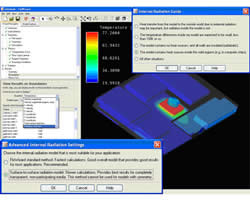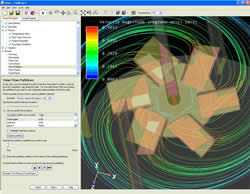FloWizard 3.0 Released
More automation, polyhedral cells, better MCAD connectivity, and improvements for automotive, HVAC, and electronics designers among major changes.
Latest News
July 25, 2007
By Anthony J. Lockwood
 The Fluent subsidiary (Lebanon, NH) of ANSYS, Inc. (Canonsburg, PA) has released version 3.0 of its FloWizard rapid flow modeling software for the validation of designs early in the production development cycle. Version 3.0 has been enhanced with new and improved functionality for design and process engineers in such industries as automotive, electronics, HVAC, and power. Version 3.0 also offers new tools and improvements in all areas of its domain, including physics, meshing, plotting, and MCAD connectivity.
The Fluent subsidiary (Lebanon, NH) of ANSYS, Inc. (Canonsburg, PA) has released version 3.0 of its FloWizard rapid flow modeling software for the validation of designs early in the production development cycle. Version 3.0 has been enhanced with new and improved functionality for design and process engineers in such industries as automotive, electronics, HVAC, and power. Version 3.0 also offers new tools and improvements in all areas of its domain, including physics, meshing, plotting, and MCAD connectivity.
FloWizard 3.0 now supports the use of polyhedral cells, which are said to enable faster convergence than previous methodologies. Version 3.0 also offers a high level of automation that makes easier tasks that traditionally have required a lot of manual intervention. For example, version 3.0 automatically performs such tasks as meshing, solution steering, and reporting. For users in the automotive and HVAC industries, FloWizard 3.0 now has models for fans and vents placed at inlets, outlets, and inside the flow domain. These models enable the analysis of ventilation in rooms and in climate-control systems. Additionally, new cylindrical porous media models enhance performance predictions for catalytic converters and mew radiation models provide better analysis of heat transfers.
Version 3.0 offers new associative connections with Pro/Engineer and UGS NX. This enables you to set up and perform a FloWizard calculation for a model, make a parametric change in Pro/E or NX, then update your FloWizard model with the modified MCAD model without having to set it up again. A connection for Autodesk Inventor 11 is now available, and FloWizard 3.0 can now read CATIA V5R16 and V5R17 files.
Improvements in the geometric capabilities include annular boundaries, the ability to specify the axis of rotation by clicking on the model (as well as manually entering the coordinates of the rotation axis), and the ability to use a separate slider bar for mesh density, numerical accuracy, and convergence. A new Geometry Cleanup tool provides user control over the geometry cleanup options. Physics and solver enhancements include internal radiation models for both transparent and participating media and an option to set boundary conditions. FloWizard offers a new pressure-far-field boundary condition for external flows. You can now enter resistances for porous regions in cylindrical, conical, and Cartesian coordinates, and you can specify heat sources in fluid and porous regions, as well as in solid regions.
Physics and solver enhancements include internal radiation models for both transparent and participating media and an option to set boundary conditions. FloWizard offers a new pressure-far-field boundary condition for external flows. You can now enter resistances for porous regions in cylindrical, conical, and Cartesian coordinates, and you can specify heat sources in fluid and porous regions, as well as in solid regions.
Among the post-processing and graphics enhancements are the ability to clip plane cuts and iso-surfaces by variable or by region. You can now also draw the velocity vectors and pathlines relative to the motion of the rotating machinery, and lines can be drawn on contours. Additionally, you can now save animations in MPEG format.
FloWizard 3.0 runs on 32-bit and 64-bit Windows with a minimum of 512 MB RAM (1-2GB recommended), 400MB disk space, and professional-level Open GL graphics cards. Click here for full details on supported platforms.
To access a DE review of the previous version of FloWizard, click here. To see a free 10-minute online demo, click here or click here for a free PDF of product specifications. To sign up for a live online demo or an evaluation unit, click here.
To go to the FloWizard landing page for complete details on the new and improved features in version 3.0, click here.
Subscribe to our FREE magazine, FREE email newsletters or both!
Latest News
About the Author
Anthony J. Lockwood is Digital Engineering’s founding editor. He is now retired. Contact him via [email protected].
Follow DE





